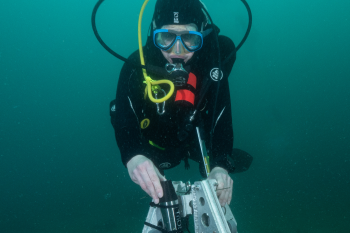© Pint of Science, 2025. All rights reserved.
My relationship with my brother Andy is like most relationships between brothers: we find each other annoying, make each other laugh, and push each other around. However, when people find out that Andy is autistic, I think they tend to imagine my relationship with Andy as being very different. But as previously mentioned, I don’t see my relationship with Andy as different. But there’s no denying that Andy is unique. We are all unique, but Andy is uniquely unique. Having lived with Andy all my life, I like to think I know all of Andy's idiosyncrasies. But as a scientifically inclined individual, one thing I am ashamed of not knowing, is the actual cause of autism. So, I’ve done some reading, and this is what I’ve found thus far.
Autism is a developmental condition. Its characteristics can best be described by the ‘Diagnostic and Statistical Manual of Mental Disorders’ (DSM) written by the American Psychiatric Association. The diagnostic criteria of autism outlined by the DSM identifies two main characteristics:
- Deficits in social communication and interaction
Autistic people can struggle to perform back-and-forth conversations, share information, and respond to social cues. They can also struggle with non-verbal communication (e.g. eye contact, facial expressions) and developing relationships.
- Restricted and/or repetitive patterns of behaviour
Autistic people may repeat certain movements, obsess over routine, or fixate on certain interests. They can also be very sensitive, or contrastingly, unresponsive to sensory stimulation.
But these characteristics can vary in both their type and severity leading to all sorts of different experiences of autism. This variety is the reason for autism often being referred to as a ‘spectrum’.
Image Description: Jack and his brother overlooking a lake
Certain genes have been recognised to be associated with autism. These genes play a role in brain development and neuron activity. Neurons are the messengers of the brain, and when variations in autism-related genes occur, these neurons can be more reluctant to send messages. But it seems there are more than genes at play.
A recent study was performed by the National Institute of Child Health and Human Development (NICHD), that studied identical twins on the autism spectrum. It was found that the identified autistic traits of twins diagnosed with autism, varied greatly. The researchers estimated that this trait variation was a result of genetic variation only 9% of the time. So, what’s causing that variety of traits 91% of the time? It’s not a genetic cause, and it’s not an environmental cause as twins develop in the same uterus and are raised under the same roof. In short, the underlying cause of autism and its variation is still unknown. But it’s thought that if this mystery is solved, then autistic people can be better supported.
Another way autistic people can be better supported, is through better autism diagnosis. Up until 2018, diagnostic practices and standards were performed differently depending on the state you were in, and the sector performing the testing (e.g. health, education, or disability services). The ‘National Guideline for the Assessment and Diagnosis of Autism Spectrum Disorders in Australia’ published in 2018 improved the situation greatly by introducing guidelines for autism diagnosis that would be used across all states and all sectors. However, issues remain. Autism assessments can be expensive, time-consuming, and hard to access for rural families. Thankfully, much research is being undertaken to remedy this.
Research being performed by the University of New South Wales is one example. The research involved tracking the eye movements of 74 children as they watched side-by-side images of geometric patterns and children performing yoga exercises. Although it sounds odd, it has been established that individuals on the autism spectrum have a preference for watching moving geometric shapes, and an aversion to observing social activities. The duration and location of the children's staring was recorded, and a program used that data to classify whether the child was or wasn’t autistic. The program was able to predict an autism diagnosis with an accuracy of 95%. The researchers believe that eye-tracking technology could be used to identify the presence of autism and its severity. This new autism diagnosis method could greatly improve the cost, duration, and accessibility of autism diagnoses.
But I don’t need a professional eye tracker to tell me where my brothers' eyes are. Andy’s not looking at geometric shapes, or children performing yoga exercises. He’s eyeing off my share of the hot chippies. He’s got eyes bigger than his belly, just like all brothers.
Should you wish to understand autism more, please visit Autism Spectrum Australia’s website here. Autism Spectrum Australia, or ‘Aspect’ for short, is Australia’s largest autism-specific service provider. Their aim - provide the best possible opportunities for people on the spectrum.
References
Hodges, H., Fealko, C., & Soares, N. (2020). Autism spectrum disorder: definition, epidemiology, causes, and clinical evaluation. Translational pediatrics, 9(Suppl 1), S55.
American Psychiatric Association. (2022). Diagnostic and statistical manual of mental disorders (5th ed., text rev.). https://doi.org/10.1176/appi.books.9780890425787
Castelbaum, L., Sylvester, C. M., Zhang, Y., Yu, Q., & Constantino, J. N. (2020). On the nature of monozygotic twin concordance and discordance for autistic trait severity: a quantitative analysis. Behavior Genetics, 50, 263-272.
Vivanti, G., & Whitehouse, A. (2021). National guideline for the assessment and diagnosis of autism spectrum disorders in Australia. In Encyclopedia of Autism Spectrum Disorders (pp. 3070-3072). Cham: Springer International Publishing.
de Belen, R. A. J., Eapen, V., Bednarz, T., & Sowmya, A. (2024). Using visual attention estimation on videos for automated prediction of autism spectrum disorder and symptom severity in preschool children. Plos one, 19(2), e0282818.
Bottema-Beutel, K., Kapp, S. K., Lester, J. N., Sasson, N. J., & Hand, B. N. (2021). Avoiding ableist language: Suggestions for autism researchers. Autism in adulthood.




